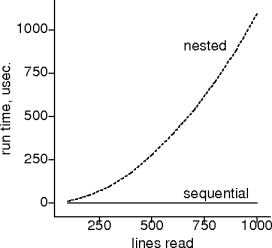Outline
- Characterizing algorithms and programs.
- Measuring and estimating.
- Asymptotic estimates.
- A behavior hierarchy.
- Structural analysis.
- Examples
An Algorithm
- Algorithm 1.
string read
while getline(cin, str)
read += str
for i = 0 to read.size()
if read[i] == '<'
// process tag
Another Algorithm
- Algorithm 2.
string read
while getline(cin, str)
read += str
for i = 0 to read.size()
if read[i] == '<'
// process tag
read[i] = ' '
- Which algorithm is better?
- And what does “better” mean?
Comparing Algorithms
- There are many algorithms, all different.
- Which algorithm can be judged suitable?
- It depends on your criteria.
- Memory use, speed, message count, ...
- Testable, maintainable, reusable, ...
- Consentrate on stable, easily quantifible resource use.
Measuring Performance
- Wire up the algorithm and measure its resuorce use.
- Measure execution time, storage use, and so on.
- Measurements give definitive answers.
- Measurements give comparative answers.
- Smaller (or bigger) is better.
Measuring Problems
- Meaningful measurements are hard.
- Measurements are context dependent.
- Determining context accurately is difficult.
- Comparing results is hard.
- Contexts must match to be meaningful.
- But algorithms don’t execute; they’re not code.
- It requires implementing the algorithm.
Estimated Performance
- If you don’t know, guess (or estimate).
- Ignore the details, go for the big picture.
- Estimating is simpler than measuring.
- At a cost of being less representative.
- Skillful professionals estimate well.
- Estimation is a skill to develop.
Estimation Advantages
- Estimation works for algorithms.
- Estimates are more comparable then are measurements.
- The context is mostly ignored when estimating.
- Estimates are more durable than are measurements.
- Not as closely tied to hardware or software technology.
Estimate What?
- If you can measure it, you can estimate it.
- And maybe even if you can’t measure it.
- Start with execution time.
- Performance is usually related to other criteria.
- It takes time to use a resource.
- Make sure you understand what’s being estimated.
Modeling Estimates
- A problem of a particular size causes an algorithm to use a particular
amount of resource.
- Model a resource estimate as a function f(n).
- The algorithm is reduced to a function, other details abstracted away.
- Make sure you understand what the input and output represent.
Functional Model
- Model resuorce use as a function f(n).
- f(n) is the estimated resource for an input of size n.
- What can n represent?
- Whatever’s important: bits, lines, records.
- What can f(n) represent?
- Whatever’s important: behavior in time or space, messages,
errors, dollars.
Sorting Example
- The function f(n) models resources used by a sorting algorithm.
- n is the number of elements being sorted.
- Alternative: n is the number of bits being sorted.
- f(n) is the time it takes to sort n elements.
- Alternative: f(n) is the number of comparisons made to sort
n elements.
Database Example
- The function f(n) models the resources used by a
distributed-database consensus algorithm.
- n is the number of machines over which the database is
distributed.
- Alternative: n is the percentage machines not responding.
- f(n) is the number of messages it takes to reach reach
consensus.
Estimate Comparisons
Bounding Functions
- After modeling an algorithm by f(n), estimate
f(n)’s behavior.
- There are many ways to estimate f(n)’s behavior.
- An upper bound on f(n)’s behavior is useful.
- It represents potential worst-case behavior.
- Other bounds are possible, but harder to find.
Upper-Bounds
- An upper bound of f(n)’s behavior is a
function g(n) with the property that
C*g(n) ≥ f(n)
as n grows without bound for some positive constant C.
- In other words f(n) is never larger than g(n).
- It’s an asymptotic estimate because n grows
without bound.
Big-Oh Notation
- An alternative representation for f(n)’s upper bound
is O(f).
- That is, g(n) = O(f).
“The function g is bounded above by the function f.”
- The actual interpretation of “g(n) = O(f)” is
strange.
- Sometimes also known as worst-case estimates.
Known Estimates
- After a while, the same estimates come up again and again.
- The estimates also tend to be familiar functions.
- These estimates form a set of well-known signposts.
- The set of well-known estimates serve as a yardstick for comparing
estimates.
Constant Behavior
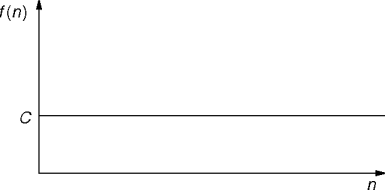
- This is input-independent behavior
- This is the ideal behavior.
- But watch out for the value of C.
Logarithmic Behavior
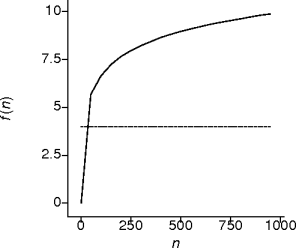
- This is repeated dividing behavior.
Linear Behavior
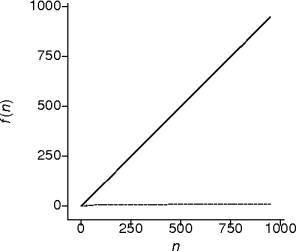
- This is touch every element behavior.
Log-Linear Behavior
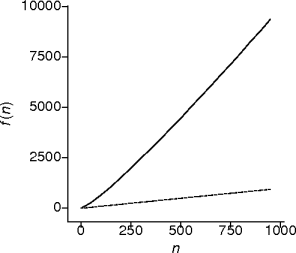
- This is sorting behavior.
- Repeatedly divide for every element.
Quadratic Behavior
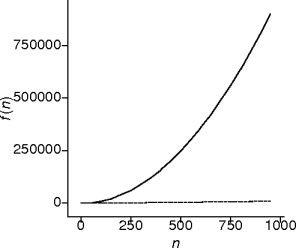
- This is double loop behavior.
Exponential Behavior
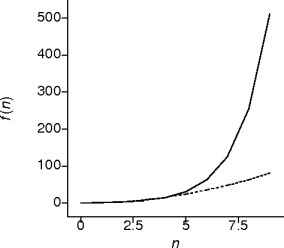
- This is systematic guessing behavior.
Factorial Behavior
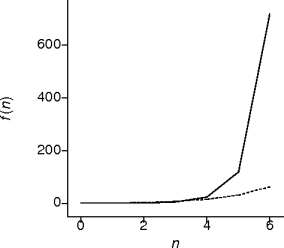
- This is permutation generating behavior.
A Behavior Hierarchy
| Constant | | O(1), hash table searching |
| Log | | O(log n), binary search |
| Linear | | O(n), linear search |
| Log-linear | | O(n log n), heapsort |
| Quadratic | | O(n2), bubble sort |
| Exponential | | O(2n), subsetting |
| Factorial | | O(n!), optimal route finding |
- Higher is better.
- A given value of n produces smaller numbers.
A Family Portrait
- Let n = 100.
| f | f(n) |
|---|
| C | C |
| log n | 4.6 |
| n | 100 |
| n log n | 460.5 |
| n2 | 10,000 |
| n3 | 1,000,000 |
| 2n | 1,267,650,600,228,229 × 1015 |
| n! | 93,326,215,443,944,152 × 1046 |
Comments
- Except for small n, improving asymptotic behavior is important.
- Don’t fiddle with the code, fiddle with the algorithm.
- Move down to the next lowest level of asymptotic behavior.
- When n is small, practically any algorithm will do.
Asymptotic Estimate Properties
- For any f(n), f(n) = O(f).
- O(f) + O(g) is O(max(f, g)).
- Larger estimates swallow up smaller estimates.
- max(f, g) may not exist as n grows without bound.
- O(f)*O(g) = O(fg).
- The product of estimates is the estimate of the product.
Producing Estimates
- Given an algorithm how do you produce an estimate?
- After you've decided on the input and output meanings.
- There are several techniques for producing estimates from algorithms.
- Usually used in combination.
- Structural analysis is a simple and straightforward technique.
Structural Analysis
- Algorithms have a regular structure.
- Statements, sequences, loops, and choice.
- Use program structure to derive asymptotic estimates.
- Assign behavior to smaller units.
- Combine units following algorithm structure to find behavior of
larger units.
- Repeat until the whole algorithm’s been combined into a
single estimate.
Running Example
Statements
- Usually O(1), but know your data structures.
- Compare
vec.size() with lst.size().
- Estimate the simple statements.
i = 0
while i < n
j = i + 1
while j < n
if a[i] > a[h]
swap(a[i], a[j])
j++
i++
|
O(1)
while i < n
O(1)
while j < n
if a[i] > a[h]
O(1)
O(1)
O(1)
|
if Statement
-
if b s1 else s2
- Execute either
s1 or s2, but which one?
- Because we’re overestimating, use the larger of the
estimates.
- Don’t forget
b’s cost.
if Example
- Estimate the if statements.
O(1)
while i < n
O(1)
while j < n
if a[i] > a[h]
O(1)
O(1)
O(1)
|
O(1)
while i < n
O(1)
while j < n
O(1) + O(1) = O(1)
O(1)
O(1)
|
Statement Sequence
-
s1 ; s2
-
s1 is O(f), s2 is O(g), so s1; s2 is
O(f) + O(g)
- What is O(f) + O(g)?
- Treat O(f) as a set of functions, pick a representative
function and apply the definition of big-oh.
- Take the larger of the two.
- O(f) + O(g) is O(max(f, g))
Sequence Example
- Estimate the statement sequences.
O(1)
while i < n
O(1)
while j < n
O(1)
O(1)
O(1)
|
O(1)
while i < n
O(1)
while j < n
O(1) + O(1) = O(max(1, 1)) = O(1)
O(1)
|
Loops
-
while b do s
-
s has asymptotic estimate O(f).
-
s gets executed some number of times.
- Asymptotically bound the number of times as O(g).
- The estimate is O(f)*O(g).
- O(f)*O(g) is equivalent to O(f*g)
Loop Overhead
- The loop itself does constant work per iteration.
- Ignore it.
- This includes the cost of evaluating
b.
- An implicit, and occasionally troublesome, assumption.
Loop Example
- Estimate the loops.
O(1)
while i < n
O(1)
while j < n
O(1)
O(1)
|
O(1)
while i < n
O(1)
O(n)*(O(1) + O(1)) = O(n)
O(1)
|
To Finish.
- Estimate the statement sequence.
O(1)
while i < n
O(1)
O(n)
O(1)
|
O(1)
while i < n
O(1) + O(n) + O(1) = O(n)
|
- Estimate the loop
O(1)
while i < n
O(n)
|
O(1)
O(n)*O(n) = O(n2)
|
To Finish..
- Estimate the statement sequence.
O(1)
O(n2)
- Done: O(n2).
- The structure of the algorithm determines the next step.
Subroutines
- Non-recursive subroutines are treated like a statement.
- Guess at or know the estimate for a call.
- Recursive calls are tougher.
Be Wary
- Always treat estimates with suspicion.
- Pay attention to the constants, and to the assumptions made.
- In particular, what's the input and output (resource) assumptions?
Constants
- Keep an eye on the constants.
- Asymptotically identical algorithms may be (usually are) different.
- For small n, constants are more important - linear search is
usually good enough.
- Small estimates with large constants may be worse than a large estimate
with a small constant.
Input and Output
- Estimate the right things.
- What’s important: an expensive algorithm, or the number of
times it’s called?
- Look at the right inputs.
- Focus on what’s driving the algorithm.
- Worrying about execution time on communication-bound computations.
Remember This?
string read
while getline(cin, str)
read += str
for i = 0 to read.size()
if read[i] == '<'
// process tag
- Read in a string, then process all tags.
And This?
string read
while getline(cin, str)
read += str
for i = 0 to read.size()
if read[i] == '<'
// process tag
read[i] = ' '
- Likewise: read in a string, then process all tags.
- Which program is better?
Let's Estimate!
while getline(cin, str)
read += str
for i = 0 to read.size()
if read[i] == '<'
// process tag
- What’s the input?
- It could be lines or characters processed.
- What’s the output?
- How about statements executed.
Basic Statements
- Take input to be lines processed.
- Assume n lines were read.
while getline(cin, str) : O(1)
read += str : O(1)
for i = 0 to read.size() : O(1)
if read[i] == '<' : O(1)
// process tag : O(1)
Compound Statements
while O(1) : O(n)
O(1)
for O(1)
if O(1) : O(1)
O(1)
- The while loop iterates O(n) times, executing O(1) + O(1) =
O(1) statements on each iteration.
- The if statement executes O(1) + O(1) = O(1) statements.
Iteration Statements
O(n)
for O(1) : O(1)
O(1)
- The for loop iterates O(n) times.
- O(1) characters per line * O(n) lines.
Statement Sequences
O(n)
O(n)
- O(n) + O(n) = max(O(n), O(n)) = O(n).
- The number of statements executed is proportional to the number of
lines read.
Second Program
- Reduce the basic statements.
while getline(cin, str) : O(1)
read += str : O(1)
for i = 0 to read.size() : O(1)
if read[i] == '<' : O(1)
// process tag : O(1)
read[i] = ' ' : O(1)
Compound Statements
while O(1)
O(1)
for O(1)
if O(1)
O(1)
O(1)
|
while O(1)
O(1)
for O(1)
O(1)
|
while O(1)
O(1)
O(n)
|
- The for loop iterates in proportion to the number of lines read.
Finishing Up
- O(n)*O(n) = O(n*n) = O(n2).
- O(n) vs. O(n2): the first program wins!
Does It?
Points to Remember
- Develop algorithms not programs.
- Code programs from algorithms.
- Use performance criteria to select algorithms.
- Keep in mind other criteria.
- Use asymptotic estimates for performance.
- Remember these are estimates.
- Estimate performance using structural analysis.
- Let the algorithm give you the next step.
- Understand what the estimates are saying.
- Which algorithm is the better performer?
|
This page last modified on 11 September 2008.
|

|








